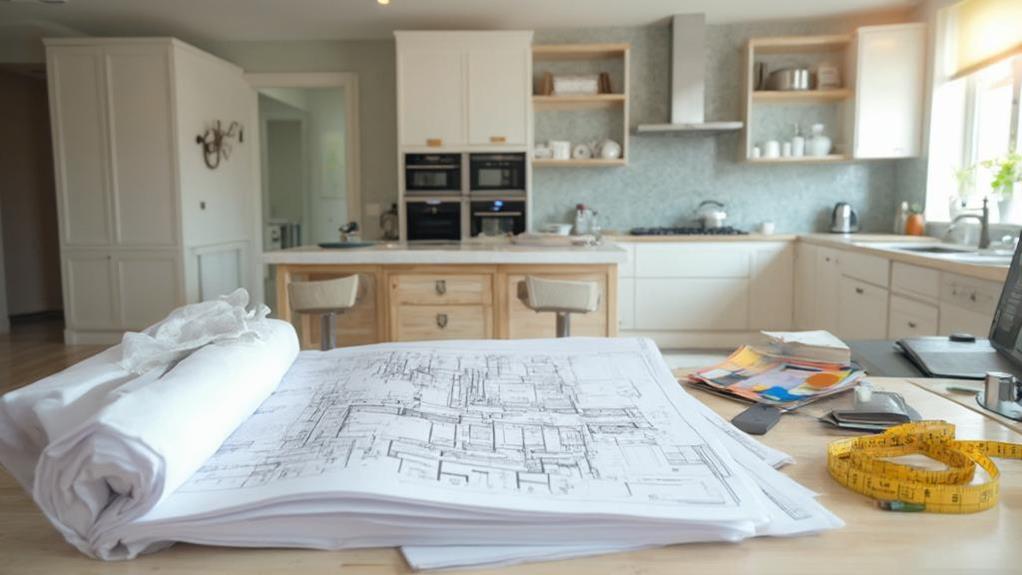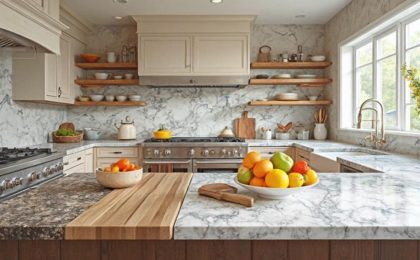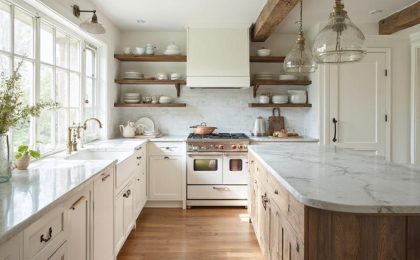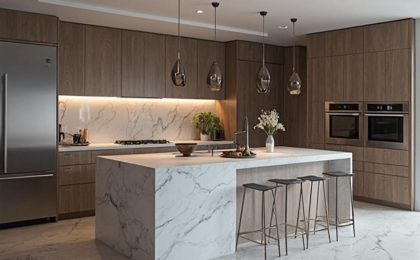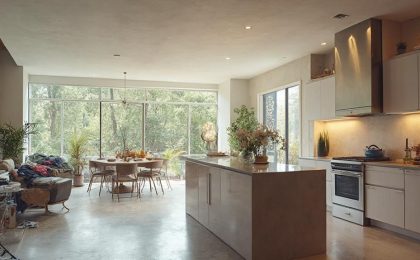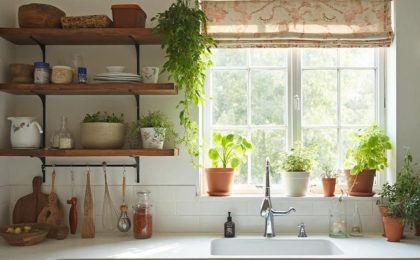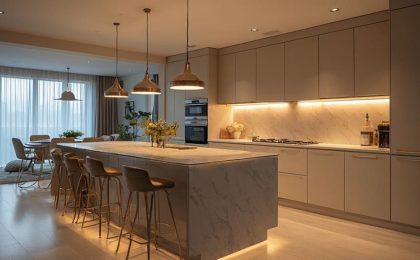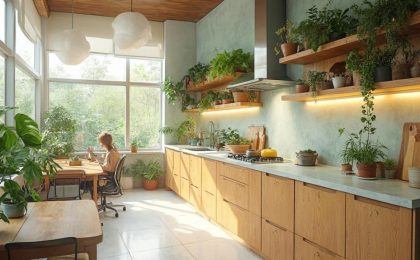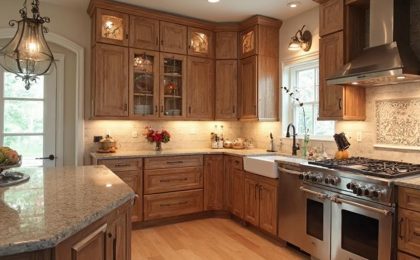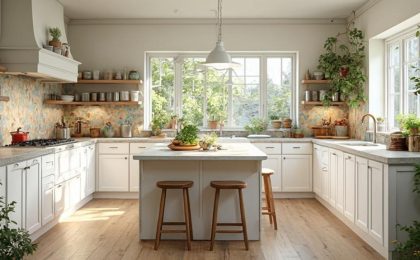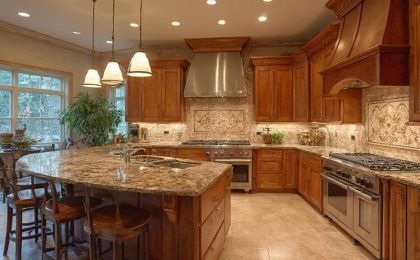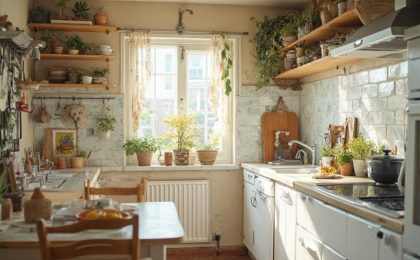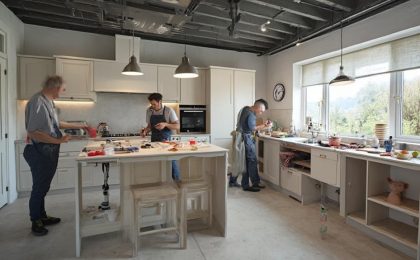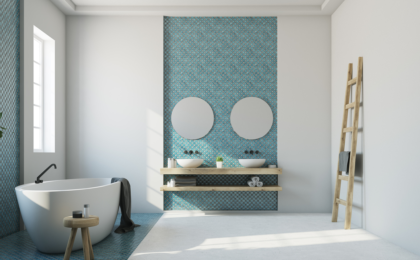When you’re planning a kitchen renovation, it’s crucial to approach it methodically to guarantee a successful outcome. Start by defining your renovation goals and evaluating your budget, as these will guide your decisions throughout the process. You’ll need to measure your kitchen space accurately to create a functional layout that enhances workflow. But before you get too far, there are key considerations to keep in mind that might influence your choices greatly. Curious about what those are? Let’s explore the next steps together.
Key insights
- Define your renovation goals by evaluating current functionality and lifestyle needs for effective planning.
- Set a realistic budget, including a contingency for unexpected expenses, to avoid financial strain.
- Research various design styles and create a mood board to visualize your desired aesthetic.
- Measure your kitchen space accurately to ensure proper fit for appliances and design elements.
- Decide between professional help or DIY based on your skills, time availability, and project complexity.
Define Your Renovation Goals
When you initiate a kitchen renovation, the first step is to clearly define your renovation goals. Think about what you want to achieve and how it’ll fit into your daily life.
Start by evaluating your current kitchen functionality. Is there enough counter space for meal prep? Do you have sufficient storage for your gadgets and groceries? Identifying these aspects will help you prioritize your needs.
Next, consider your lifestyle. If you often entertain guests, an open layout or a larger island might be essential.
Perhaps you’re a budding chef who needs a dedicated cooking zone. Reflect on how your family interacts in the kitchen—are they active participants or do they prefer to keep it simple?
Set a Realistic Budget
Before you start tearing down cabinets and picking out countertops, it’s vital to set a realistic budget.
Begin by estimating the total costs of your renovation, ensuring you allocate funds for essentials like appliances and materials.
Don’t forget to set aside a little extra for those unexpected expenses that always seem to pop up!
Determine Total Cost Estimate
Setting a realistic budget for your kitchen renovation is essential to ensuring a smooth and successful project. Start by calculating your total kitchen cost, taking into account every detail from cabinetry to countertops. This will help you establish a thorough renovation budgeting plan that keeps surprises at bay.
Here’s a simple breakdown of potential expenses:
| Expense Category | Estimated Cost Range | Notes |
|---|---|---|
| Cabinets and Hardware | $2,000 – $8,000 | Custom vs. stock options |
| Countertops | $1,000 – $5,000 | Material impacts cost |
| Appliances | $1,500 – $10,000 | Brand and energy efficiency |
| Flooring | $1,000 – $3,000 | Type of material matters |
Gather quotes from contractors and suppliers to refine these figures. Allocate a contingency fund of about 10-20% for unexpected costs. By being meticulous now, you’ll avoid financial strain later. Remember, a realistic budget not only meets your needs but also reflects your vision for a dream kitchen.
Allocate Funds for Essentials
With a solid cost estimate in hand, you’re ready to allocate funds for the essentials of your kitchen renovation.
Begin by identifying your essential priorities—items that will considerably impact both functionality and aesthetics. Think about vital elements like cabinets, countertops, and appliances. These should take precedence in your budget.
Use budgeting tips to guarantee you’re not overspending on non-essentials. Create a list of what you absolutely need versus what you’d like to have. For example, while a high-end refrigerator might be a dream, a mid-range model may fit your budget better without sacrificing quality.
Next, consider where you can save. Perhaps you can refinish your cabinets rather than replace them entirely. Small adjustments can lead to notable savings.
Allocate a specific percentage of your budget to each essential category, guaranteeing you leave room for high-impact items.
Account for Unexpected Expenses
You never know when unexpected expenses might pop up during a kitchen renovation, so it’s crucial to set a realistic budget that accounts for these surprises. Every renovation has its own set of challenges, from discovering hidden water damage behind cabinets to needing unexpected plumbing upgrades.
To navigate these hurdles, consider creating a contingency fund—typically around 10-20% of your overall budget. This renovation buffer guarantees you won’t have to scramble for cash if something goes awry.
Start by estimating your total costs, including materials, labor, and appliances, then add your contingency fund on top of that. When you allocate these funds, it gives you peace of mind, knowing you can deal with unforeseen issues without derailing your project.
Keep your contingency fund separate from your main budget to avoid the temptation to dip into it for non-emergencies. As you progress through your renovation, monitor your spending closely. If you find you haven’t used all your contingency funds, great! You can either upgrade some features or keep it for future home projects.
Planning for the unexpected can turn potential headaches into manageable bumps in the road.
Research Design Styles
When diving into a kitchen renovation, understanding various design styles can greatly influence your choices and the overall outcome. Start by exploring modern aesthetics, which emphasize clean lines, minimalism, and open spaces.
Think about sleek cabinetry, stainless steel appliances, and a neutral color palette that creates a fresh, inviting atmosphere. This style is perfect if you want a contemporary feel that’s both functional and stylish.
On the other hand, if you’re drawn to nostalgia, classic motifs might be more your speed. Imagine rich wood cabinetry, intricate moldings, and warm, inviting colors that evoke a sense of timelessness.
Elements like a farmhouse sink or vintage light fixtures can enhance this aesthetic, giving your kitchen a cozy, welcoming charm.
As you research, gather inspiration from magazines, websites, and social media platforms like Pinterest. Create a mood board that reflects your vision, combining elements from both modern aesthetics and classic motifs, if that’s your style.
Ultimately, understanding these design styles will help you make informed decisions that align with your personal taste and the functionality you need in your kitchen.
Measure Your Kitchen Space
Before you pick out that stunning backsplash or sleek countertop, you need to measure your kitchen space accurately.
Grab a tape measure and note down the key areas like cabinets, appliances, and countertops to guarantee everything fits perfectly.
With precise measurements in hand, you’ll avoid costly mistakes and make your renovation process much smoother.
Tools for Accurate Measurement
Accurate measurements are the backbone of a successful kitchen renovation, guaranteeing that every element fits perfectly and functions smoothly.
To achieve accurate dimensions, you’ll want to use the right measuring tools. Here’s a quick list to include in your renovation checklist:
- Tape Measure: A flexible tape is essential for measuring lengths and widths of your kitchen space. Opt for one that’s at least 25 feet long.
- Laser Measure: For quick and precise measurements, a laser measure can save you time and reduce human error.
- Square: A framing square helps you check right angles, guaranteeing your cabinets and counters are aligned correctly during space planning.
- Level: A level guarantees that everything is even, from countertops to shelving, preventing future headaches.
Key Areas to Measure
Now that you’ve equipped yourself with the right tools for precise measurements, it’s time to focus on the key areas of your kitchen that need attention.
Start by measuring your kitchen dimensions, including the length and width of the room. Don’t forget to check the height of your ceilings, as this can influence your cabinetry choices.
Next, measure the space for appliances. You’ll want to account for your fridge, oven, and dishwasher. Use measuring techniques like the tape measure to guarantee you get the exact sizes, including the depth of appliances—this can help you avoid unpleasant surprises later.
After that, measure your countertops. Consider both the length and depth, since these dimensions will affect your workspace.
If you’re planning an island, measure where it will go to ensure it fits seamlessly.
Create a Functional Layout
When designing your kitchen, creating a functional layout is essential for maximizing both efficiency and comfort.
A well-planned kitchen workflow guarantees you can move seamlessly between tasks, while space optimization allows you to make the most of your available area.
Here are four key elements to take into account:
- Work Triangle: Position your sink, stove, and refrigerator in a triangular layout. This minimizes unnecessary steps and enhances your cooking efficiency.
- Zones: Designate specific areas for cooking, prep, and cleaning. Each zone should be equipped with the necessary tools and storage to streamline your tasks.
- Counter Space: Confirm you have ample counter space near your cooking zone for chopping, mixing, and plating. This will reduce clutter and improve workflow.
- Storage Solutions: Incorporate cabinets and drawers that maximize vertical space.
Take into account pull-out shelves and lazy Susans to keep everything organized and accessible.
Select Materials and Finishes
After establishing a functional layout, the next step in your kitchen renovation is selecting materials and finishes that reflect your personal style while ensuring durability and practicality.
Start with countertops—choose a surface that balances aesthetics with material durability. Quartz and granite offer stunning looks and resist scratches, while butcher block provides warmth but requires more upkeep.
Next, consider cabinetry. Opt for solid wood or engineered materials that promise longevity. If you’re drawn to painted finishes, remember they might need touch-ups over time, so think about how much finish maintenance you’re willing to undertake.
For flooring, hardwood and tile are popular choices, each with its own charm and upkeep needs. Tile is often easier to clean and can withstand spills, making it a practical option.
Choose Appliances and Fixtures
Your kitchen’s functionality hinges on the right appliances and fixtures, so it’s essential to choose wisely. Start by considering energy efficiency, which not only helps the environment but also saves you money in the long run. Look for ENERGY STAR-rated appliances that meet strict efficiency guidelines.
Here’s a quick checklist to guide your selection:
- Refrigerator: Opt for a model with adjustable shelving and temperature controls to keep your food fresh and organized.
- Oven/Range: Choose between gas or electric, based on your cooking preferences. Convection ovens can cook food faster and more evenly.
- Dishwasher: Select a quiet, energy-efficient model that fits your kitchen space and handles the load you typically generate.
- Faucet: Pick a fixture that combines style with functionality. Look for pull-down sprayers and low-flow options for improved water efficiency.
When selecting appliance brands, research their reliability and warranty offerings.
A well-chosen combination of appliances and fixtures can transform your kitchen into a stylish and efficient cooking haven.
Plan for Lighting
Good lighting can dramatically enhance both the aesthetics and functionality of your kitchen, creating an inviting space for cooking and gathering. You’ll want to reflect on a blend of ambient lighting and task lighting to achieve that perfect balance. Ambient lighting provides overall illumination, while task lighting focuses on specific areas where you’ll be chopping, mixing, or baking.
Here’s a simple breakdown to help you visualize your lighting plan:
| Type of Lighting | Purpose |
|---|---|
| Ambient | General illumination |
| Task | Focused on work areas |
| Accent | Highlight features |
| Under-cabinet | Illuminate countertops |
| Pendant | Stylish focal points |
When planning, think about the areas in your kitchen that need extra light. Under-cabinet lighting can enhance your workspace, while pendant lights above an island can add style and functionality. Mix these elements to create a warm, inviting atmosphere that caters to both your cooking needs and social gatherings. This combination not only brightens your space but also elevates its overall appeal. So, get creative and plan your lighting wisely!
Hire Professionals or DIY
Deciding whether to hire professionals or tackle a kitchen renovation as a DIY project can feel like an intimidating crossroads. Each option comes with its own set of advantages and challenges, so it’s essential to weigh them carefully.
Here are four key factors to reflect on:
- Skill Set: Assess your own competencies. If you’re handy with tools and have experience, the DIY route may save you money and provide a sense of accomplishment.
- Time Commitment: DIY renovations can be time-consuming. If you have a busy schedule, hiring a contractor might be more efficient and less stressful.
- Complexity of the Project: For major renovations involving plumbing or electrical work, you’ll want professionals with the right contractor qualifications to guarantee safety and compliance with local codes.
- Budget: While DIY can reduce labor costs, unexpected expenses often arise. A qualified contractor can provide a detailed estimate to help you avoid budget overruns.
Ultimately, the choice between hiring professionals or going DIY hinges on your skills, time availability, project complexity, and budget evaluations.
Make the decision that aligns best with your renovation goals!
Frequently Asked Questions
How Long Does a Kitchen Renovation Typically Take?
When you’re considering a kitchen renovation, timeline estimation can vary widely.
Typically, the entire process takes about 6 to 12 weeks, depending on your project’s complexity. You’ll go through several renovation phases, from design and demolition to installation and finishing touches.
If you plan well and communicate with your contractor, you can keep everything on track.
What Permits Do I Need for My Renovation?
When you’re planning your kitchen renovation, you’ll need to take into account various permit types depending on your kitchen layout.
Typically, you’ll need a building permit for structural changes, electrical permits for any wiring updates, and plumbing permits if you’re modifying fixtures.
Don’t forget to check local zoning laws and homeowner association rules.
Getting the right permits not only guarantees compliance but also protects your investment in your dream kitchen.
How Can I Minimize Disruption During the Renovation?
To minimize disruption during your renovation, set up a temporary kitchen in another part of your home.
Use a microwave, toaster oven, and a small fridge to keep meals simple.
Plan your renovation schedule thoughtfully, coordinating with contractors to guarantee work happens efficiently.
Communicate with your family about meal times and any noise expectations, so everyone stays on the same page.
This way, you can enjoy your home while the transformation unfolds!
What Common Mistakes Should I Avoid?
When planning your kitchen renovation, avoid common mistakes like neglecting budget allocation and rushing design choices.
You might underestimate costs, leading to overspending. Make sure you prioritize essentials and leave room for unexpected expenses.
Don’t skip thorough research on materials and layouts; they can greatly impact functionality.
How Do I Handle Unexpected Costs?
When unexpected costs arise, it’s vital to stay calm and reassess your budget.
You should’ve included a budget buffer or cost contingency to absorb these surprises. If you didn’t, consider reallocating funds from less critical areas.
Keep communication open with your contractors about any changes, and always prioritize essential repairs over cosmetic upgrades.
Flexibility and a proactive mindset can help you navigate these challenges smoothly without derailing your entire project.
Summary
By following this step-by-step guide, you’re well on your way to transforming your kitchen into a space that’s both beautiful and functional. Remember, it’s all about clarity in your goals, sticking to your budget, and embracing your style. Whether you choose to tackle the renovation yourself or bring in the pros, each decision you make brings you closer to your dream kitchen. So roll up your sleeves, get excited, and let your creativity shine!
